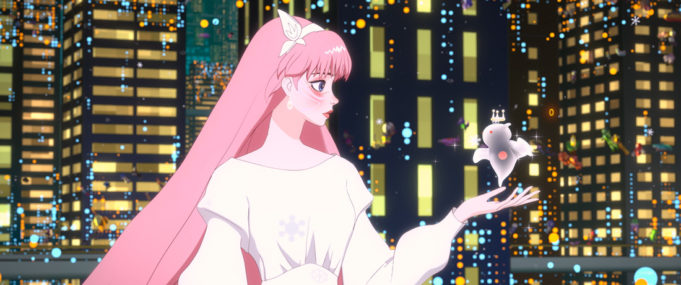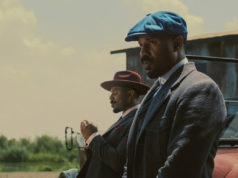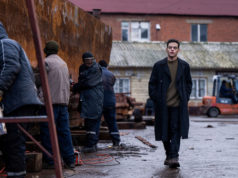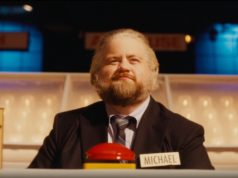This past year, I spent more time in multiplexes than anyone who doesn’t work for a movie theater, and I didn’t get sick. Vaccinations work, people. Also, the Hollywood blockbusters returned, and some of them worked, too, even though others made me feel sick. In that sense, pre-pandemic service resumed. Some of the films on this list were on streaming services, so I watched them at home, but nothing quite replaces the communal experience of taking in the same story at once with a crowd, just as our cave-dwelling ancestors did while gathered around a fire. Here are the experiences since last March that meant something to me.
1. Belle. Mamoru Hosoda cracks the code for incorporating musical numbers into a Japanese anime film. That alone would be a big achievement, but he’s also made the best movie I’ve ever seen about social media. The story (about a teenage girl who creates a pink-haired pop princess as an online alter ego) steals from Hannah Montana and Disney’s Beauty and the Beast, and somehow has its heroine rescuing a boy from his abusive home without straining. Surpassingly beautiful and emotional, this film opens locally next month, so watch for it.
2. Limbo. Of all the movies about the refugee crisis, none are as funny as this British entry about a group of Muslims stuck in a halfway house in the windswept wilds of Scotland while the justice system sorts out their legal status. Writer-director Ben Sharrock plays the cultural dislocation for spacey, surreal comedy as the refugees try to comprehend the locals’ English and not go insane from boredom. The final sequence with Amir El-Masry’s musician finally playing his oud for the first time since his exile is one of the year’s most satisfying endings.
3. In the Heights. Lin-Manuel Miranda’s first Broadway musical becomes a better, cinematic version of itself in this film that deserved a bigger audience. Every number has its own distinctive touch, from the giant cloth swatches in “It Won’t Be Long Now” to the epic scope of “Paciencia y Fe” to the pool dance of “96,000.” On a bigger budget, director Jon M. Chu reaches heights not hinted at by the Step Upsequels he directed and turns this into a hit of joy that makes you want to dance on the side of a building.
4. Titane. Possibly the gnarliest French film you’ll ever see, this tale of a woman who turns the tables on predatory men comes with Cronenberg-level body horror, as its protagonist (Agathe Rousselle, making a sizzling film debut) undergoes anatomical changes after having sex with cars. Along the way, this serial killer learns the value of kindness and nurturing while taking refuge with a fire captain. French cinema has come back to life thanks partly to its women filmmakers, and writer-director Julia Ducournau is one of that country’s brightest and most perverse new talents.
5. The Green Knight. North Texas’ David Lowery makes it onto my list, and his medieval epic is so good that I’m not even worried about being accused of homerism. With a predominantly British cast, he renders the 700-year-old epic poem into an appropriately alien-feeling meditation on honor and the fleeting nature of the world’s pleasures. The film’s design makes it look at once modern and immeasurably ancient, and Dev Patel’s performance as Gawain is enough to make an argument for color-blind casting. We can say we knew the director before anybody else did.
6. This Is Not a Burial, It’s a Resurrection. About time an African movie cracked my Top 10, don’t you think? The first film I ever saw from the country of Lesotho is bound up in its people’s lore and geography, as Mary Twala Mhlongo (who died shortly after filming this) gives a raw and agonized performance as an 80-year-old widow whose ancestral homeland is scheduled to be flooded by a new dam and who refuses to abandon the place where she wants to be buried. Writer-director Lemohang Jeremiah Mosese uses bright colors and eerie sounds to make this story of a disappearing way of life into something uncanny.
7. There Is No Evil. Despite the best efforts of Iran’s theocratic dictatorship, filmmakers in that country still turn out provocative movies like Mohammad Rasoulof’s anthology drama. Four connected stories show characters working around the enforcement of capital punishment, which can be handed down for crimes like drinking alcohol, publishing pornography, and simple theft. You won’t soon forget the single-take shot (oddly similar to one from No Time to Die) of a soldier resorting to extreme measures to avoid executing a prisoner. Nor will you forget how the characters’ actions ripple through time.
8. Drive My Car. Slated to play here in Fort Worth next month, this much-feted Japanese awards contender is worth the hype. Adapted from a Haruki Murakami short story, this three-hour road-trip movie is about a theater director (an anguished Hidetoshi Nishijima) coping with the sudden loss of his wife by traveling to Hiroshima to helm a production of Chekhov’s Uncle Vanya. Writer-director Ryûsuke Hamaguchi makes Chekhovian drama out of the main character’s long car trips between his lodging and the theater as he breaks in a new cast, works through his grief, and finds the wherewithal to act again.
9. Passing. There’s just so much that’s wrenchingly right about this Netflix film. Rebecca Hall (a mixed-race actress who does not look the part) makes a stunning filmmaking debut with this adaptation of Nella Larsen’s novel about two light-skinned Black classmates in the 1920s, one of whom decides to pass for white and marries a rich white man. Ruth Negga gives a career-best performance as the friend who goes undercover that way, and the whole thing is photographed in black and white that’s so sharp it’ll make you cry. So will the crushing tragedy that the story builds to.
10. The Worst Person in the World. Why don’t we give more consideration to Joachim Trier as one of the world’s greatest filmmakers? The Norwegian excels whether he’s doing coming-of-age saga (Reprise), addiction drama (Oslo, August 31st), or supernatural thriller (Thelma). This comedy takes in a young woman (the helplessly sexy Renate Reinsve) who hits 30 without figuring out what to do with her life, and it’s like a Scandinavian version of Fleabagor Girls. Trier’s visual gambits pay off handsomely, and when death unexpectedly hits someone close to our main character, it’s deeply affecting.
Honorable mention: Steven Spielberg’s electrifying update of West Side Story … Michael Sarnoski’s somber, cracked study of grief, Pig … Anders Thomas Jensen’s hilarious revenge thriller, Riders of Justice … Craig Gillespie’s punk-rock fashion fantasia, Cruella … Asghar Farhadi’s complex saga of a prisoner and a lost purse, A Hero … Maggie Gyllenhaal’s dislocated meditation on motherhood, The Lost Daughter … Burhan Qurbani’s sharp modern update of Berlin Alexanderplatz … Sean Baker’s raucous romp through a pornstar’s discontent, Red Rocket … Roy Andersson’s career-capping dystopian farce, About Endlessness … Guillermo del Toro’s nihilistic neo-noir tragedy, Nightmare Alley … Radu Jude’s formally innovative tale of a high-school sex tape, Bad Luck Banging or Loony Porn … Dash Shaw’s psychedelic animated film about animal rights, Cryptozoo … Paolo Sorrentino’s love letter to his Neapolitan hometown, The Hand of God … Heidi Ewing’s docudrama gay immigrant romance, I Carry You With Me … Céline Sciamma’s enchanting childhood time-travel story, Petite Maman … Charlène Favier’s disquieting #MeToo skiing drama, Slalom … Edgar Wright’s 1960s fever dream, Last Night in Soho … Clint Bentley’s chronicle of a Jockey’s last ride … Michael Pearce’s study of a Marine gone mad, Encounter … and Siân Heder’s look at growing up with deaf parents, CODA.












